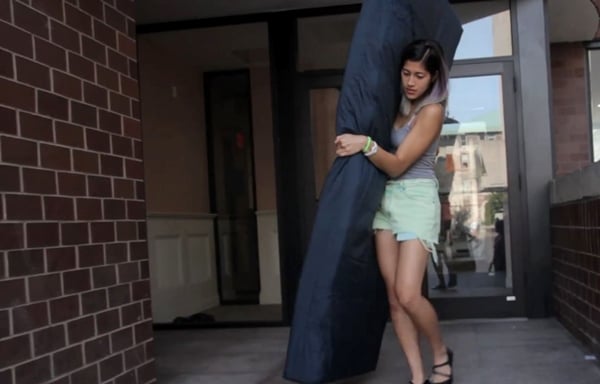Law & Politics
Columbia Student’s Striking Mattress Performance
Emma Sulkowicz is using art to call attention to sexual assault on campus.

Emma Sulkowicz is using art to call attention to sexual assault on campus.

Ben Davis

Mattress Performance: Carry That Weight is almost certainly already one of the most important artworks of the year. I don’t think that’s a stretch to say.
You won’t find it in the volley of gallery shows opening in Chelsea tonight, though. Instead, Mattress Performance, in case you haven’t yet heard, is a performance art piece by Emma Sulkowicz, a 21-year-old Columbia University studio art major who has vowed, in an inspired bit of absurdist-activist theater, to haul a twin college dorm mattress with her everywhere she goes until the man she says raped her on the first day of her sophomore year leaves Columbia.
You may have already heard about Sulcowicz’s case. She has written about her experience for Time, been interviewed by the New York Times, and was one of 23 Columbia and Barnard students who filed a Title IX complaint in April of this year, accusing the administration at their schools of systematic mishandling of sexual assault cases. Sulkowicz appeared with senator Kirsten Gillibrand at a press conference about sexual assault, and was one of the students involved in posting “rape lists” in campus bathrooms at Columbia earlier this year, publicly naming her own alleged attacker as a warning to other students (two other women have accused the same man of sexual assault; campus authorities have exonerated him each time).
But her just-launched Mattress Performance, which Sulkowicz has embarked on as her senior thesis, has broken through in a new way entirely, winning a vast amount of media attention in the last few days, from Al Jazeera to the Telegraph to MTV. In fact, I can hardly think of an artwork in recent memory that justifies the belief that art can still help lead a conversation in quite the way Mattress Performance already has.
“One of the rules of the piece is that I am not allowed to ask for help in carrying the mattress, but others are allowed to give help if they come up and offer it,” Sulkowicz told the Columbia Spectator, in the video embedded above. “So, I’m hoping that not only do I get better at carrying the mattress, but other people will learn about the piece… I’m not hoping that everyone comes in and helps, but I’m very interested in seeing where this piece goes and what sort of life it takes on.”

Emma Sulkowicz’s Carry That Weight.
Photo: Via YouTube.
Given the stakes, the question of whether Mattress Performance “is art” is probably a distraction. Still, Sulkowicz’s mattress follows in a proud tradition. The present-day image of the field has been taken over by the pop-goth cult of Marina Abramović, but much of performance art grew alongside and out of the activist consciousness-raising of feminism in the 1960s and ’70s. Often this meant that it went beyond the gallery, attempting to make the hidden oppression faced by women—including sexual violence—pointedly public.
I think of Ana Mendieta’s Untitled (Rape Scene) (1973), made while she was an art student studying Intermedia art at the University of Iowa, a personal response to a then-recent violent campus rape and murder of Sara Ann Ottens by a fellow student (and tragically haunting now, given the circumstances of this artist’s own death). She invited classmates to her apartment, where they found her, bloodied and prone, amid a scene arranged to resemble reports of the scene of the crime.
Mendieta went on to restage variations of the graphic scene in outdoor venues across campus, an act which, Nina Kane writes, “underlined the reality—that no space domestic or otherwise could be considered ‘safe’ in light of the student’s murder, that rape was something that could be encountered—terrifyingly—anywhere.”
More relevant still to Sulkowicz might be Suzanne Lacy and Leslie Liebowitz’s influential Three Weeks in May (1977), a righteous, multiform public performance that sought to make visible the issue of rape in Los Angeles. The project included theater, testimonials, and guerrilla graffiti marking the spots of reported sexual assaults, with the anchoring centerpiece being a public display charting every rape reported during the project’s three-week run.
“What this map is about, what the whole project is about, is women speaking out to each other, sharing the reality of their experience,” Lacy said in a speech during the event. “By exposing the facts of our rapes, the numbers of them, the events surrounding them, and the men who commit them, we begin to break down the myths that support the rape culture.”
For now, the coverage Sulkowicz has inspired is positive, and the usual chorus of people grumbling is confined to social media and the scrum of comments sections. Still, it is worth saying that Mattress Performance: Carry That Weight not just is art, but takes performance art back to what made it seem relevant in the first place—which is part of why Sulkowicz’s action has captured the imagination the way it has. Sadly, it also shows that things haven’t changed enough.